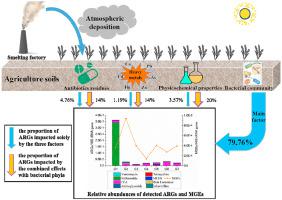European Journal of Soil Biology ( IF 3.7 ) Pub Date : 2020-12-24 , DOI: 10.1016/j.ejsobi.2020.103269 Fan Yang , Fengli Zhang , Hongping Li , Huiying Wu , Hongcheng Zhao , Xuemin Cheng , Yue Ba , Hui Huang , Shuaiyin Chen , Jingyuan Zhu

|
Antibiotic resistance (AR) has become a potential concern to public health. It is mainly associated with the overuse and misuse of antibiotics in the environment. Several factors influence the development and dissemination of antibiotic resistance genes (ARGs); however, the relative contribution of these factors has been scarcely characterized. To study the impact of each factor, we examined the effects of five antibiotics, eight heavy metals, five physicochemical properties, and bacterial community on the abundance of 310 ARGs in agricultural soils collected near a smelter. Tetracycline was found in the highest levels of all the samples compared to the other four antibiotics, with the most severe contamination (1738.534 μg/kg) occurring in the sample farthest from the plant (2556 m), whereas the highest copy number of ARGs (sulfonamide resistance genes, 3.63 × 10−1 copies/16SrRNA) and the worst heavy metal pollution (Cd, 18.900 mg/kg; Pb, 1938.000 mg/kg) were detected in the sample closet to the plant (741 m). Pearson and Spearman rank correlation analysis showed that the abundance of 84 ARGs was impacted by these four factors in the soil. The bacterial phyla contributed to 79.76% of ARGs variation, whereas antibiotics, heavy metals, and physicochemical properties contributed 4.76%, 1.19%, and 3.57%, respectively. Bacterial community was the main factor influencing the distribution of ARGs. Antibiotics and heavy metals may affect the distribution of ARGs not only by themselves but also by influencing the structure of bacterial community in the soil. The research provides insights into the different contributions of factors to AR control.
中文翻译:

环境因素对农业土壤中抗生素抗性基因分布的贡献
抗生素抗性(AR)已成为公共卫生的潜在问题。它主要与环境中抗生素的过度使用和滥用有关。几个因素影响抗生素抗性基因(ARGs)的发展和传播。然而,这些因素的相对贡献几乎没有被表征。为了研究每个因素的影响,我们检查了五种抗生素,八种重金属,五种理化特性和细菌群落对在冶炼厂附近收集的农业土壤中310种ARG含量的影响。与其他四种抗生素相比,在所有样品中发现四环素含量最高,其中最严重的污染(1738.534μg/ kg)发生在离工厂最远(2556 m)的样品中,在距工厂约741 m的样品室中检测到-1个拷贝/ 16SrRNA)和最重金属污染(Cd,18.900 mg / kg; Pb,1938.000 mg / kg)。Pearson和Spearman等级相关分析表明,土壤中这四个因素影响了84个ARG的丰度。细菌菌群占ARGs变异的79.76%,而抗生素,重金属和理化性质分别占ARGs变异的4.76%,1.19%和3.57%。细菌群落是影响ARGs分布的主要因素。抗生素和重金属不仅会自身影响ARG的分布,还会影响土壤中细菌群落的结构。该研究提供了对因素对AR控制的不同贡献的见解。









































 京公网安备 11010802027423号
京公网安备 11010802027423号